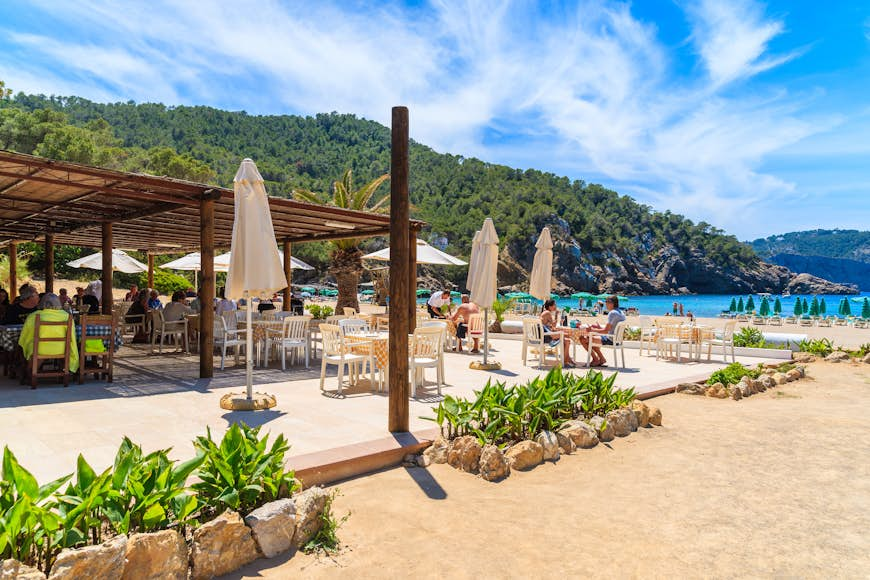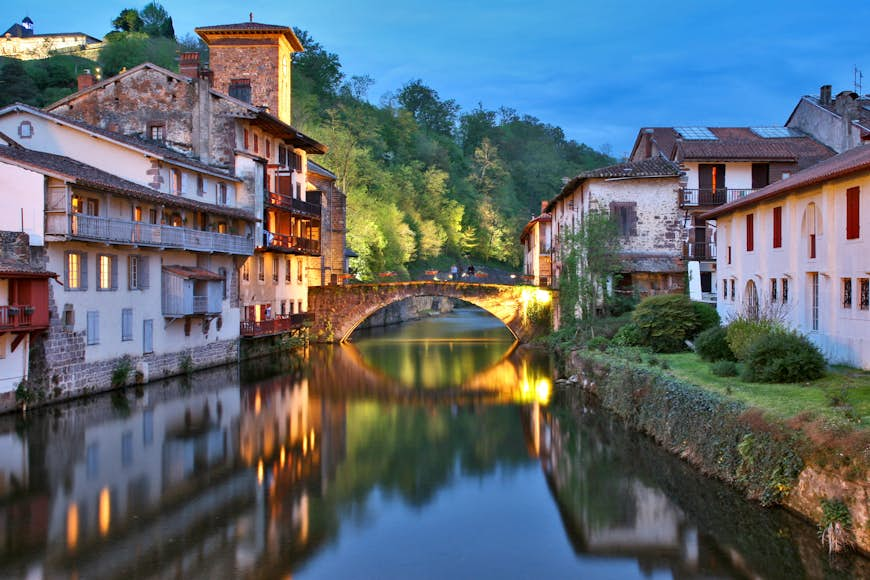
With its sun-drenched Mediterranean beaches, World Heritage cities, incredible cuisine, and multi-faceted culture, few countries in the world can tick all the traveler boxes with such a diverse range of attractions as Spain. It is truly unique.
Given Spain’s long and storied past of Catholic monarchies, Muslim caliphates and New World conquistadores one region can have a completely distinct character from the next. Here’s a rundown of the best places to visit in this standout Iberian destination.
Squeeze every moment out of your next vacation with tips and tricks from Lonely Planet in our weekly newsletter delivered to your inbox.
1. Madrid
Best city for visiting world-class art museums
The Spanish capital is a lively city blessed with year-round clear blue skies draped over its vibrant barrios (neighborhoods), architectural landmarks and famed art museums. There’s even an ancient Egyptian temple, the Templo de Debod, right in Madrid’s city center.
Art aficionados could spend days exploring Madrid’s “Golden Triangle of Art” composed of three globally renowned museums, the Museo del Prado, Reina Sofía and the Thyssen-Bornemisza, which are home to some of the world’s most valuable art collections. They are situated along Madrid’s Paseo del Prado (Art Walk), which has recently been granted Unesco World Heritage status.
Planning Tip: Madrid has a vibrant street culture that loves its wine-soaked tapas crawls. Cava Baja in the historic La Latina neighborhood is lined with quaint little bars and taverns, making it one of the best streets in the city to join locals hopping from one bar to the next to sample a selection of Iberian hams, charcuterie and cheeses.
 See how the work of Gaudí has shaped the look of Barcelona © Alexander Spatari / Getty Images
See how the work of Gaudí has shaped the look of Barcelona © Alexander Spatari / Getty Images
2. Barcelona
Best for modernist architecture
Straddling the Mediterranean and the Pyrenees mountains, the Catalonian capital is a visually stunning metropolis that stands out for its avant-garde architecture, city beaches and a Gothic Quarter that stretches back over 2000 years.
No visit to Barcelona is complete without spending time at the Sagrada Família, the obra maestra of the illustrious Catalan architect and proponent of Modernism, Antoní Gaudí. His influence on the city is everywhere, and it’s worth taking time to visit his other architectural jewels, the Casa Batlló, La Pedrera and Park Güell.
Another place where Gaudí has left his legacy is at the Plaça Reial, at the heart of the city’s two millennia-old Barri Gòtic (Gothic Quarter). The public square is lit up by decorative street lamps that were Gaudí’s first commissioned public work. This ancient neighborhood is also home to the majestic Gothic Cathedral of the Holy Cross and Saint Eulalia, which was built over two centuries from the 13th to the 15th centuries. At the border of the quarter is Mercat de la Boqueria, one of the oldest markets in Europe.
Planning Tip: Have a lunchtime visit to Mercat de la Boqueria, when the unassuming places to eat, run by charismatic owners, start to open up.
 Taste traditional pintxos in San Sebastián © Matyas Rehak / Shutterstock
Taste traditional pintxos in San Sebastián © Matyas Rehak / Shutterstock
3. San Sebastián
Best city for gourmet experiences
This alluring Basque coastal city in northern Spain is stunning, characterized by its belle epoque architecture, white sand beaches that stretch for kilometers, and blue waters of the Bay of Biscay. On a clear day, stroll along the boulevard of La Concha beach to get a feel for the locals’ sea-loving culture.
San Sebastián, or Donostia in Basque, has evolved from being a traditional whaling town into a world-famous gastronomic capital. It has the greatest concentration of Michelin-starred restaurants per square meter in Europe and is the second city in the world with the most Michelin stars (behind Tokyo).
Planning Tip: You don’t need to have a Michelin-star budget to be able to enjoy San Sebastián’s food culture that seeps from every corner. Head over to the Parte Vieja (Old Quarter), particularly along 31 de Agosto street. The streets here are lined with restaurants and bars offering dizzying rows of assorted pintxos — literally meaning “spike”. The name describes how these appetizers are presented with skewers or toothpicks for easy picking.
 Soak up the beachside vibes in Ibiza © Pawel Kazmierczak/Shutterstock
Soak up the beachside vibes in Ibiza © Pawel Kazmierczak/Shutterstock
4. Balearic islands
Best for beaches and sapphire colored waters
Anyone who’s been to these outlying islands east of the Iberian Peninsula would recognize the “Balearic blues” — the distinct shades of blue that characterize these Mediterranean waters. This archipelago’s four largest islands of Ibiza, Mallorca, Menorca and Formentera are blessed with countless beaches and calas (coves) embraced by white sand coastlines and rugged cliffs.
Among these islands, Ibiza is the most famous one, mainly for its reputation as a 24/7 party destination. Yet Ibiza’s clubbing culture is just a tiny slice of this spectacular island on the Unesco World Heritage List. It is fringed with sapphire colored waters, filled with historic fortified towns, has a plethora of hidden inlets and charming beachside restaurants and cafes. You can visit the ruins of the ancient Phoenician civilization at Sa Caleta and the Puig des Molins necropolis to get a glimpse of the ancient colonies that inhabited this island, long before the clubbers discovered it.
 Time your visit for one of Seville’s colorful festivals, such as the April Fair (Feria de Abril) © LucVi / Shutterstock
Time your visit for one of Seville’s colorful festivals, such as the April Fair (Feria de Abril) © LucVi / Shutterstock
5. Seville
Best place for cultural sightseeing
Seville is in the details — this charming Andalusian capital may give you the sensation of déjà vu, perhaps because its year-round sunny days, resplendent gardens and intricately carved palaces have made it a favored filming location for big productions from Star Wars to Game of Thrones. Its allure lies in its idiosyncratic mix — horse drawn carriages, flamenco tablaos (stages), colossal Gothic structures and Islamic stylistic details all blend together to create this multi-layered dreamscape of a city.
Seville’s rich cultural tapestry is the legacy of its long and varied history, once a Moorish capital, later the seat of the Castilian aristocracy, and then as the European gateway to the Americas after Columbus’ journey in 1492. The unique juxtaposition of cultures could not be more apparent when visiting the Seville Cathedral, the largest Gothic cathedral in the world and the final resting place of Columbus, and then just a few meters away, the Real Alcázar showcasing the splendor of Mudéjar architecture with Islamic, Baroque, Gothic and Renaissance elements.
Planning Tip: Want to experience a huge celebration? Time your visit for one of the city’s great annual festivals, notably the Semana Santa and Feria de Abril.
 Toledo is known as “The City of Three Cultures” © Daugirdas Tomas Racys / Getty Images
Toledo is known as “The City of Three Cultures” © Daugirdas Tomas Racys / Getty Images
6. Toledo
Best for layers of history
This 2000-year-old walled city occupies a significant place in Spain’s history. It was the former capital of the Visigothic Kingdom, a fortress of the Emirate of Cordoba, a Roman municipium, the seat of power of King Charles V and the former capital of Spain until 1560 and is now a Unesco World Heritage Site. With Jewish, Christian and Islamic influences Toledo has earned it the nickname “The City of Three Cultures”. Walk along its narrow cobblestone streets to glimpse the vestiges of this unique cultural melange — ancient Roman structures, Moorish architectural styles, the Gothic Cathedral, the El Tránsito Synagogue and the Cristo de la Luz Mosque.
Planning Tip: Head over to the Mirador del Valle for spectacular panoramic views and a picture-perfect photo of this historic city by the Tagus River.
 Join the pilgrims in Santiago de Compostela © Tusea / Getty Images
Join the pilgrims in Santiago de Compostela © Tusea / Getty Images
7. Santiago de Compostela
Best city for spiritual tourism
Santiago de Compostela is the capital of Galicia and the final destination of the Camino de Santiago (Way of Saint James) pilgrimage, a tradition that stretches back over 1000 years. On any day of the week, you’ll see pilgrims from all over the world paying their respects at the Basilica of Santiago de Compostela, the reputed burial place of St James the Apostle.
Even non-pilgrims can relish the mystical beauty of this northern Spanish city with a distinct Celtic heritage. Its beating heart is the Plaza del Obradoiro, where stands the luxurious Hostal dos Reis Católicos, believed to be the oldest hotel in the world that was once a hostel for pilgrims.
Planning Tip: Santiago has a rich gastronomic tradition highlighted by its excellent seafood, so be hungry when you visit the city’s second most popular attraction after the Cathedral, the Mercado de Abastos food market.
 The Alhambra in Granada is an architectural masterpiece © Eszter Szadeczky-Kardoss / Shutterstock
The Alhambra in Granada is an architectural masterpiece © Eszter Szadeczky-Kardoss / Shutterstock
8. Granada
Best city for Western Islamic architecture
Situated at the foot of the snow capped Sierra Nevada mountain range is the postcard-perfect Andalusian city of Granada. It is home to the Alhambra palace complex and ancient citadel of the Nasrid Dynasty, the last Muslim dynasty in the Iberian Peninsula which ruled until the 15th century. Meaning “the Red One”, the Alhambra is a stunning architectural masterpiece merging Moorish and Christian decorative elements — it’s impossible not to feel transported to a fantasy world with its intricately carved walls and archways, mirror-like pools and colorful mosaics.
Planning Tip: Continue the visual feast at the Palacio de Generalife right by the Alhambra, a summer palace whose gardens and perfectly orchestrated fountains provided repose for the ancient Nasrid sultans.



